Sight | Site | Cite
Outlet
253 WILSON AVENUE
Brooklyn, NY
on view until September 6
Curated by Noah Becker, Jeffrey Grunthaner, and Julian A. Jimarez
Artists: Mira Alibek, Julie Tuyet Curtiss, Julia Dauksza, Heidi Howard. Irena Jurek, Nandi Loaf, Rachel Mason, Andrea McGinty. Kate McGraw, Rachel Rossin, Eric Shaw, and Weronika Twardowska

I can’t think of a group show I’ve seen this year as disorienting as Sight | Site | Cite. At the boisterous opening last weekend, several people loudly debated what was and wasn’t part of the exhibition. As is a common sight at many events in artist-run venues, there were phones plugged into outlets around the gallery. At least one of these, however, was a piece by Andrea McGinty which flashed the text “he told me not to mention his strap on” below a portrait of video artist Sondra Perry by painter Heidi Howard. Another iPhone—this one with a cracked screen—was playing garbled music from the back of a remote-controlled toy Hummer SUV. This was careening around the crowded floor, accompanied by (a performer?) who was alternately shoving gallery-goers from behind and aggressively gyrating in front of artworks. It was a lot to take in.
Mostly though, the chaotic exhibition wasn’t what I expected. Based on skimming the somewhat scattered press release, I anticipated works that engaged with the concept of “place” through familiar strategies—site specific installations, architectural interventions, or perhaps Situationist considerations of urban space. In retrospect, that vocabulary seems tragically dated. McGinty’s work perhaps best illustrates the contemporary relationship to site proposed here—nomadic, small-scale gestures that are place-less and favor immediate familiarity over “preciousness”.
In McGinty’s “Stay Positive” and “Let it go”, the artist wraps streetwear printed with fortune-cookie-like platitudes around humidifiers on the gallery floor. Occasionally releasing feeble spurts of vapor, the tiny pieces literally do alter the ambiance of the space the occupy, albeit in an oddly un-dramatic way. Both of the mass-produced consumer products McGinty uses are designed to provide some level of comfort on a modest scale. But the combination of the eponymous text and the seemingly absurd ambition of changing the moisture content of the atmosphere lent the objects a kind of sad feeling of futility. Coming to terms with a lack of personal control over one’s environment seemed to be a recurring theme in the show, moreso than straightforward responses to specific sites. I couldn’t help but view these works through the lense of generational anxieties—powerlessness in the face of climate change, a nearly-nomadic lifestyle as a result of gentrification, and the ever-accelerating changes in the natural and built environments.
In that light, the RC Hummer, Nandi Loaf’s “Untitled (whorunit.music)”, could be seen as a roaming bubble of sovereign space—aggressively colonizing (or perhaps decolonizing) whatever zone it rolls through. It evokes a party bus traversing a city; a floating island of chaotic fun in an increasingly controlled, sterile world. Scaled down to the context of a gallery, it becomes an anarchic counterpoint to the security drone—injecting mischief rather than policing order.
The car is again referenced in Eric Shaw’s “How’s My Driving?”, a painting on rubber and wood panel that sits on the floor. It’s a Memphis-School-esque remix of a car interior’s anatomy—a postmodern reduction that renders the vehicle ergonomically dysfunctional but celebrates the design cues of the iconic space. Its position on the floor further obfuscates orientation. It brings to mind a roadtrip from the era of Patrick Nagel or Gary Numan’s “here in my car, I feel safest of all”—the direction is unknown, but the trip feels glamorous.
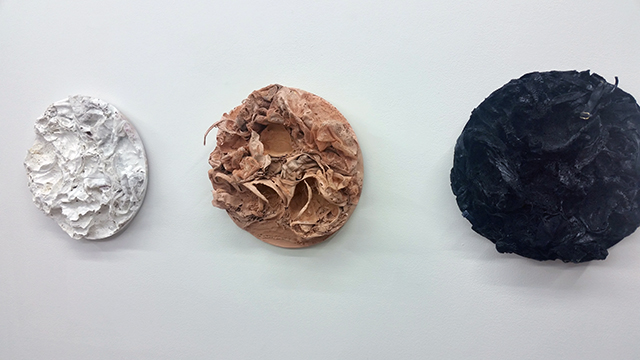
Mira Alibek “Hysterical Body (White),” “Hysterical Body (Nude),” and “Hysterical Body (Black),” 2015 Fabric (women’s underwear), polyurethane foam, epoxy resin, enamel
Throughout Sight | Site | Cite there are numerous references to travel—or, as in Mira Alibek’s Hysterical Body series, personal space—but few engagements with urban or architectural space. Perhaps, after decades of musing on modernism and its legacy, unsuccessfully fighting the destruction/gentrification of the city, and the increasing importance of digital experiences, many artists are weary of engaging with the built environment. It’s a sea change that’s noticeable beyond the realm of representation—conventional “beauty” or urban convenience no longer seems to be a determining factor of where artists or galleries locate relative to cost, as evidenced by the meteoric rise of vinyl-sided “Quooklyn” or upstate suburbs. A decade ago, there was a certain East Coast snobbery toward Los Angeles, which was derided for lacking historic streetscapes, walkability, and public transit. Today, it’s rare to hear the “it’s not a real city” complaint as droves of artists decamp for sunnier, less-crowded LA. As the mainstream becomes more interested in commodifying urbanism, perhaps it’s no longer interesting to many artists who have grown accustomed to adapting to provisional residency.
That’s not to say images of the built environment don’t still creep into the work here. Weronika Twardowska’s three photographs of Poland are great and tinged with absurdism. The unframed giclée prints are haphazardly nailed to the wall with mismatched hardware, simultaneously calling attention to the materiality of the images and placing the recognizably “fine art” objects on the same level of preciousness as the dollar-store aesthetics of many other works in the exhibition. In “Travel Office”, a sign for a travel agency—that weird, vestigial business—is overshadowed by a modernist housing block. Both the International Style architecture and the very idea of a travel agency are supposed to evoke could-be-anywhere cosmopolitanism, but the scene is so quintessentially Eastern European.
But the highlight is “While there is no Internet in the hotel”, documentation of the artist’s belongings arranged on a hotel bed to spell out “NO INTERNET”. It’s direct and funny and relatable. Haven’t we all been bored by an unexpected lack of WiFi while travelling? I’m often embarrassed by the realization that I want to be online while I could be exploring a new physical place. But as this exhibition suggests, maybe a traveler’s greatest domestic comfort is access to an even more placeless space than a hotel room.
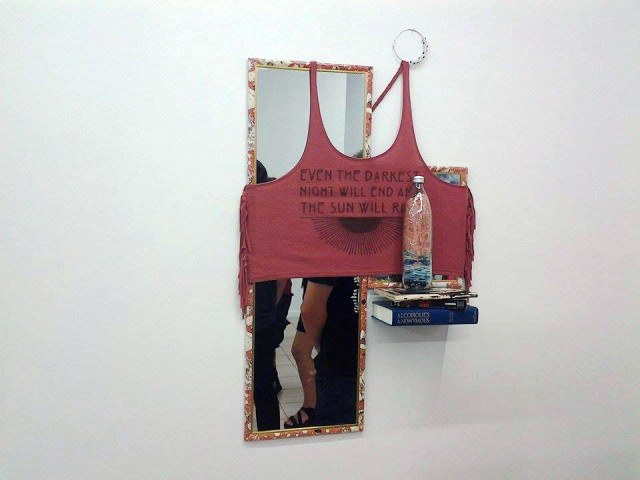
Andrea McGinty “Even the Darkest Night Will End”, 2015, 2 mirrors, Gerolsteiner sparkling water bottle, elastic hair ties, Himalayan pink sea salt, boyfriend’s 2007 artwork “Essence Precedes Exhistance,” Alcoholics Anonymous book.

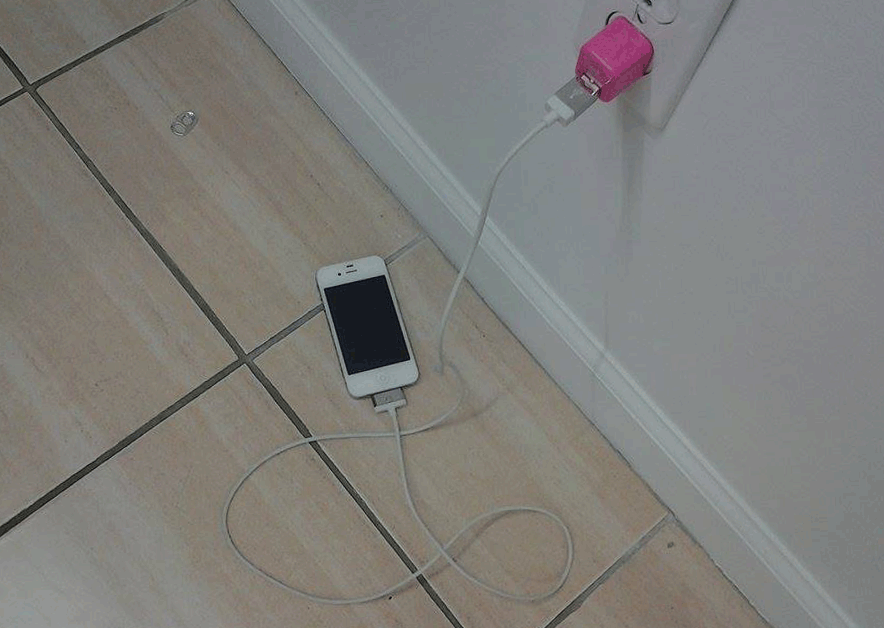

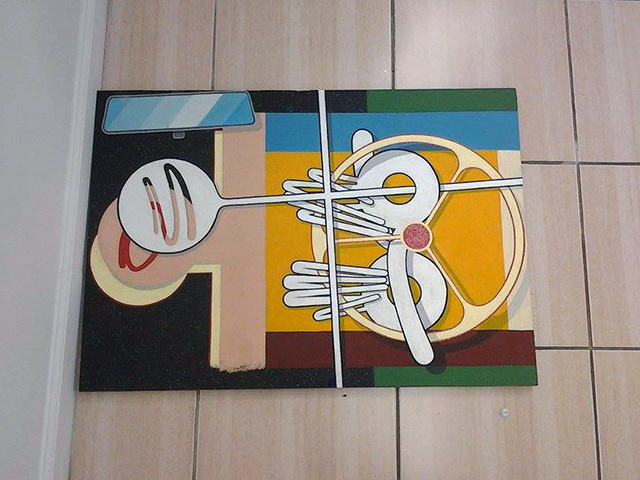
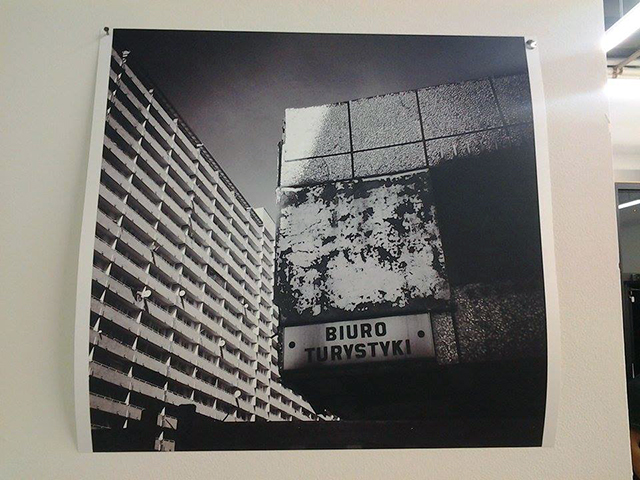
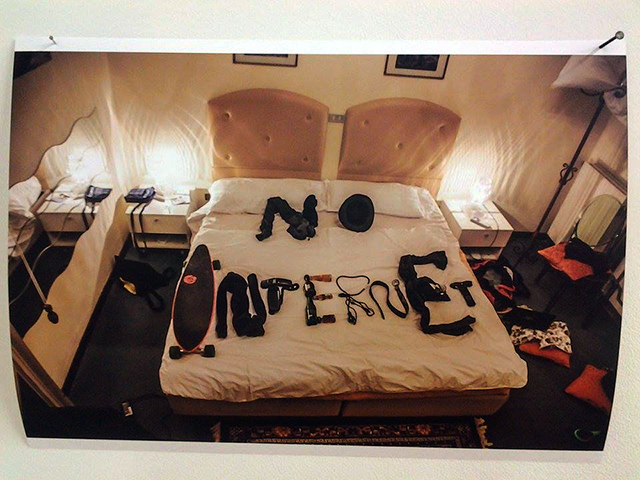
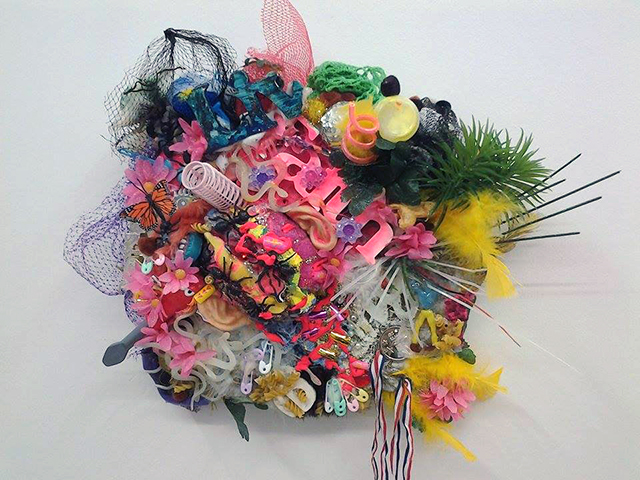
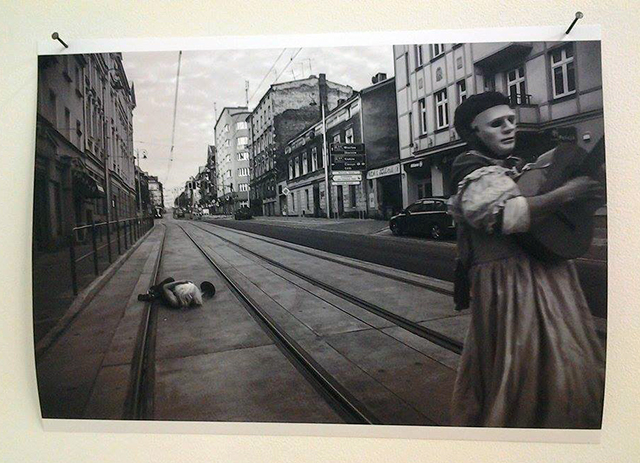
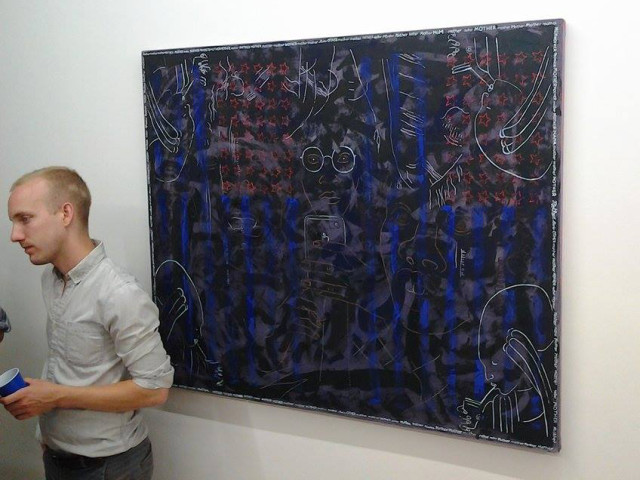

Comments on this entry are closed.
{ 1 trackback }